Abstract
Bifidobacterium, Bacteroides, and Clostridium spp. isolated from the feces of 23 neonates during the first 3 months of life were identified. Of the 23 neonates, 10 were breast fed, 6 received an infant formula with iron supplement (5 mg/liter), and 7 received the formula without iron supplement (iron concentration, less than 0.5 mg/liter). The Bifidobacterium spp. most frequently isolated from the three groups of infants were B. longum, B. breve, B. adolescentis, and B. bifidum. The bacteroides spp. most frequently isolated were B. fragilis and B. vulgatus. The most common Clostridium sp. in the three groups of infants was C. perfringens. The type of milk did not select for species of Bifidobacterium, Bacteroides, or Clostridium, except for Clostridium butyricum, which was isolated significantly more often from bottle-fed infants with iron supplement than from the other groups, and Clostridium tertium, which was more often isolated from breast-fed infants. The species of the three anaerobic genera did not persist for a long period of time in the three groups of infants.
Full text
PDF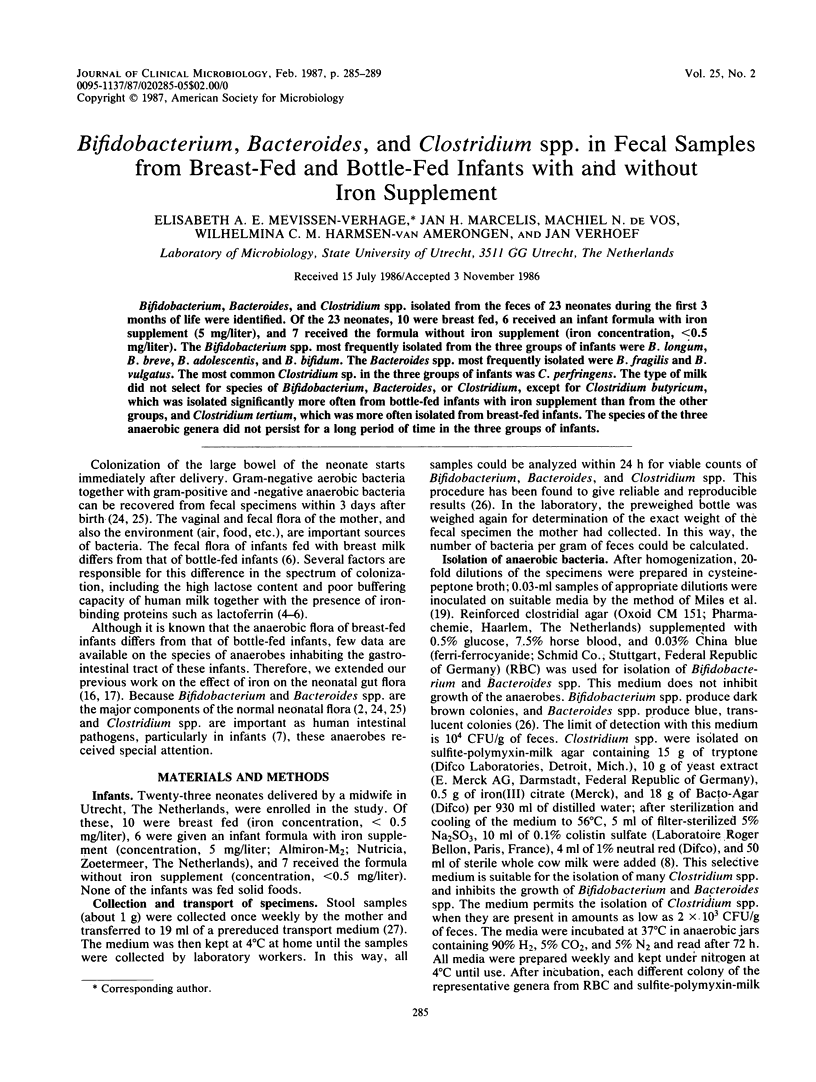
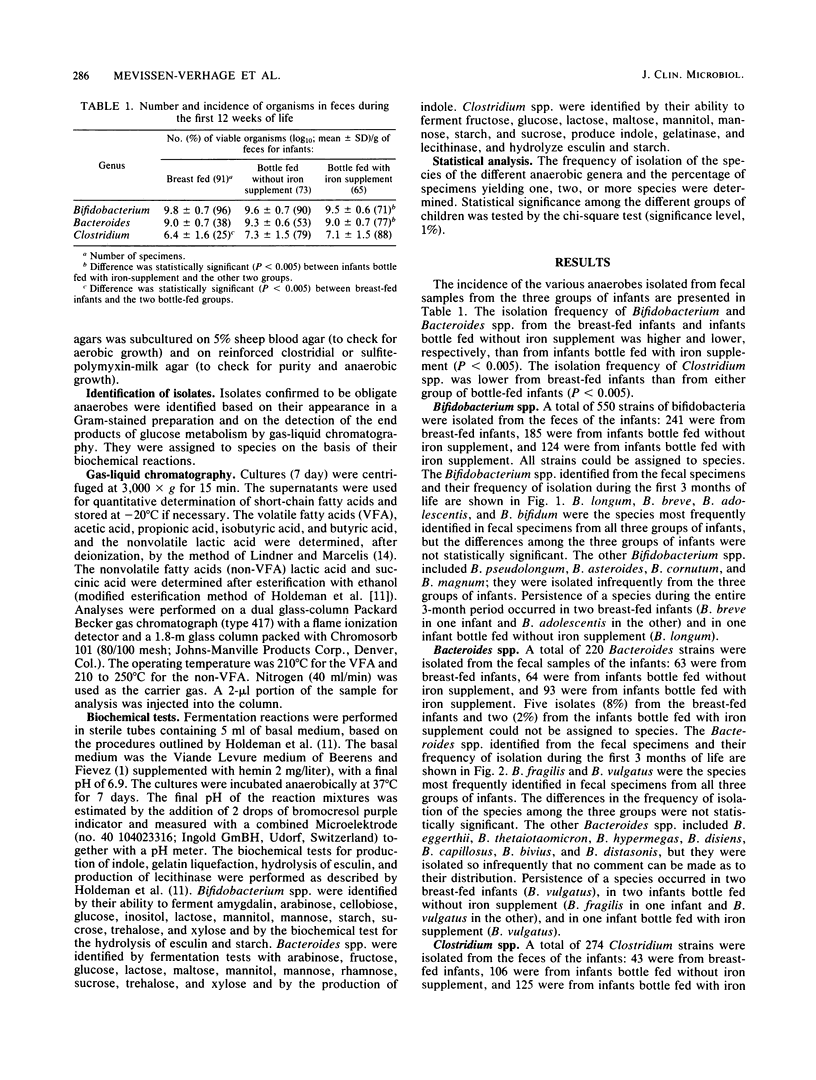
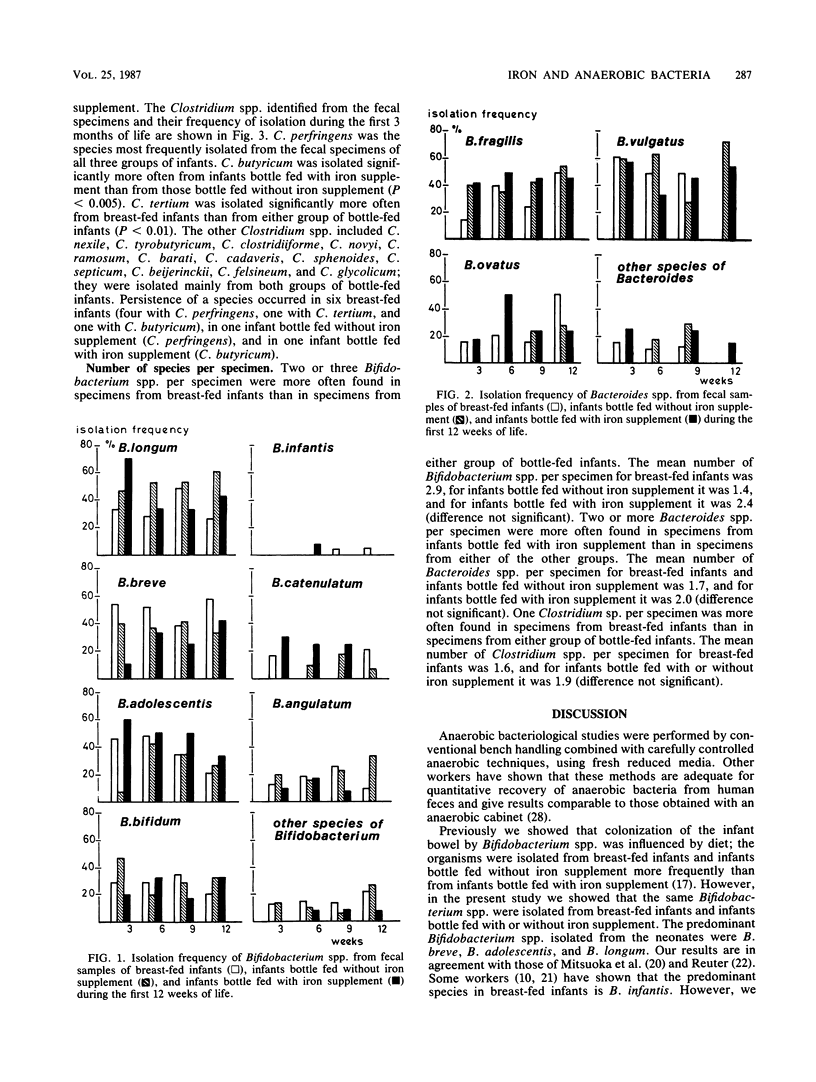
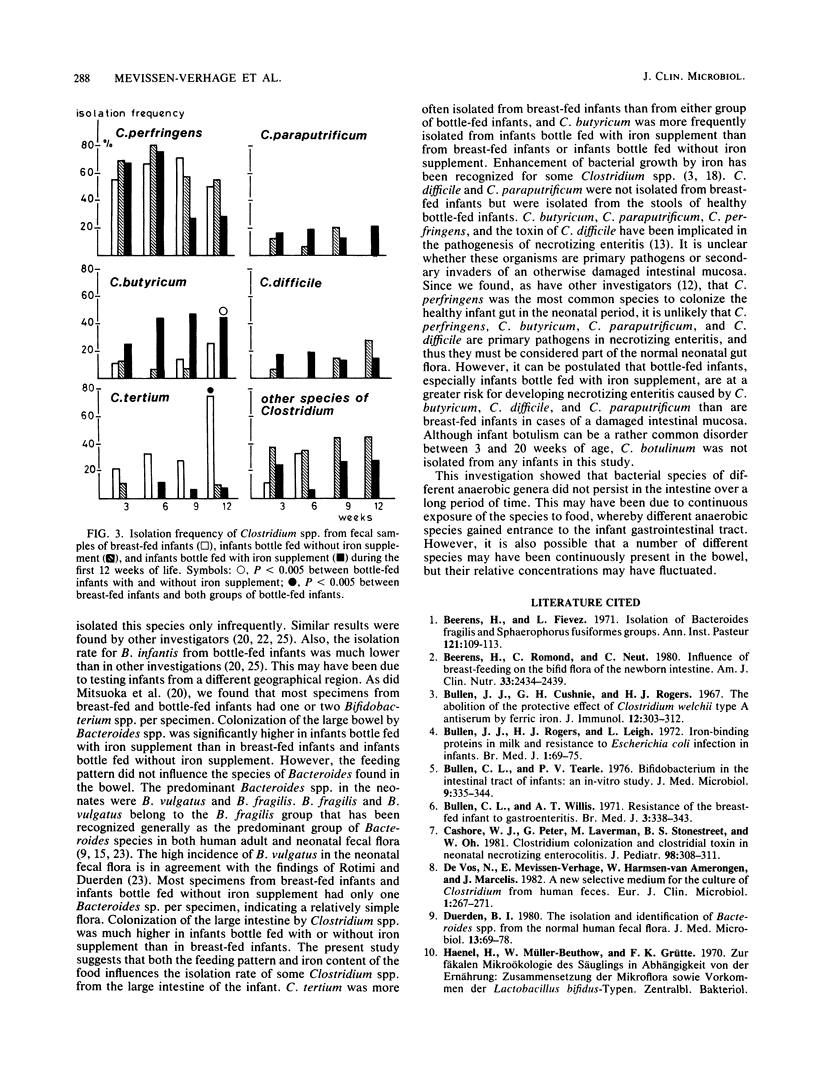
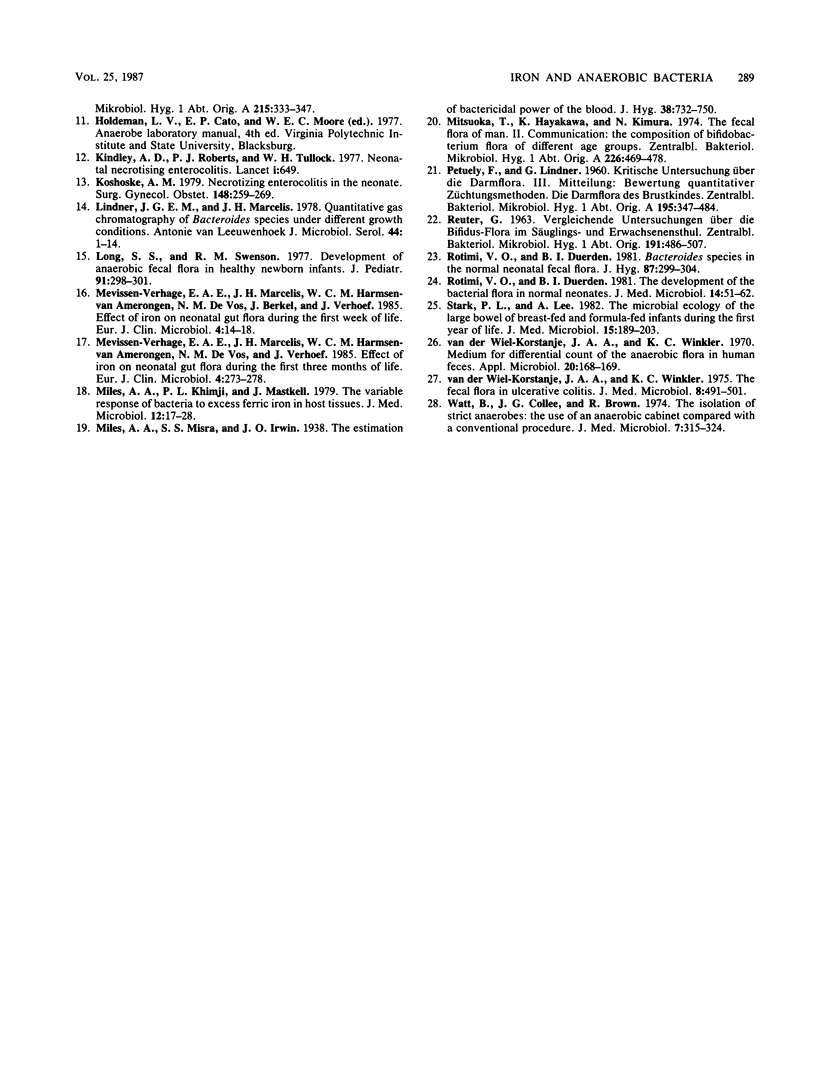
Selected References
These references are in PubMed. This may not be the complete list of references from this article.
- Beerens H., Romond C., Neut C. Influence of breast-feeding on the bifid flora of the newborn intestine. Am J Clin Nutr. 1980 Nov;33(11 Suppl):2434–2439. doi: 10.1093/ajcn/33.11.2434. [DOI] [PubMed] [Google Scholar]
- Bullen C. L., Tearle P. V. Bifidobacteria in the intestinal tract of infants: an in-vitro study. J Med Microbiol. 1976 Aug;9(3):335–344. doi: 10.1099/00222615-9-3-335. [DOI] [PubMed] [Google Scholar]
- Bullen C. L., Willis A. T. Resistance of the breast-fed infant to gastroenteritis. Br Med J. 1971 Aug 7;3(5770):338–343. doi: 10.1136/bmj.3.5770.338. [DOI] [PMC free article] [PubMed] [Google Scholar]
- Bullen J. J., Cushnie G. H., Rogers H. J. The abolition of the protective effect of Clostridium welchii type A antiserum by ferric iron. Immunology. 1967 Mar;12(3):303–312. [PMC free article] [PubMed] [Google Scholar]
- Bullen J. J., Rogers H. J., Leigh L. Iron-binding proteins in milk and resistance to Escherichia coli infection in infants. Br Med J. 1972 Jan 8;1(5792):69–75. doi: 10.1136/bmj.1.5792.69. [DOI] [PMC free article] [PubMed] [Google Scholar]
- Cashore W. J., Peter G., Lauermann M., Stonestreet B. S., Oh W. Clostridia colonization and clostridial toxin in neonatal necrotizing enterocolitis. J Pediatr. 1981 Feb;98(2):308–311. doi: 10.1016/s0022-3476(81)80667-1. [DOI] [PubMed] [Google Scholar]
- Duerden B. I. The isolation and identification of Bacteroides spp. from the normal human faecal flora. J Med Microbiol. 1980 Feb;13(1):69–78. doi: 10.1099/00222615-13-1-69. [DOI] [PubMed] [Google Scholar]
- Kindley A. D., Rboerts P. J., Tulloch W. H. Neonatal necrotising enterocolitis. Lancet. 1977 Mar 19;1(8012):649–649. doi: 10.1016/s0140-6736(77)92082-7. [DOI] [PubMed] [Google Scholar]
- Kosloske A. M. Necrotizing enterocolitis in the neonate. Surg Gynecol Obstet. 1979 Feb;148(2):259–269. [PubMed] [Google Scholar]
- Lindner J. G., Marcelis J. H. Quantitative gas chromatography of Bacteroides species under different growth conditions. Antonie Van Leeuwenhoek. 1978;44(1):1–14. doi: 10.1007/BF00400072. [DOI] [PubMed] [Google Scholar]
- Long S. S., Swenson R. M. Development of anaerobic fecal flora in healthy newborn infants. J Pediatr. 1977 Aug;91(2):298–301. doi: 10.1016/s0022-3476(77)80836-6. [DOI] [PubMed] [Google Scholar]
- Mevissen-Verhage E. A., Marcelis J. H., Harmsen-Van Amerongen W. C., de Vos N. M., Verhoef J. Effect of iron on neonatal gut flora during the first three months of life. Eur J Clin Microbiol. 1985 Jun;4(3):273–278. doi: 10.1007/BF02013651. [DOI] [PubMed] [Google Scholar]
- Mevissen-Verhage E. A., Marcelis J. H., Harmsen-van Amerongen W. C., de Vos N. M., Berkel J., Verhoef J. Effect of iron on neonatal gut flora during the first week of life. Eur J Clin Microbiol. 1985 Feb;4(1):14–18. doi: 10.1007/BF02148653. [DOI] [PubMed] [Google Scholar]
- Miles A. A., Khimji P. L., Maskell J. The variable response of bacteria to excess ferric iron in host tissues. J Med Microbiol. 1979 Feb;12(1):17–28. doi: 10.1099/00222615-12-1-17. [DOI] [PubMed] [Google Scholar]
- Mitsuoka T., Hayakawa K., Kimura N. Die Faekalflora bei Menschen. II. Die Zusammensetzung der Bifidobakterienflora der verschiedenen Altersgruppen. Zentralbl Bakteriol Orig A. 1974 Jun;226(4):469–478. [PubMed] [Google Scholar]
- Petuely F., Lindner G. Kritische Untersuchung über die Darmflora. 3. Bewertung quantitativer Züchtungsmethoden. Die Darmflora des Brustkindes. Zentralbl Bakteriol Orig. 1965 Feb;195(3):347–384. [PubMed] [Google Scholar]
- REUTER G. VERGLEICHENDE UNTERSUCHUNGEN UEBER DIE BIFIDUS-FLORA IM SAEUGLINGS- UND ERWACHSENENSTUHL. ZUGLEICH EIN BEITRAG ZUR SYSTEMATISIERUNG UND NOMENKLATUR DER BIFIDUS-KEIME. Zentralbl Bakteriol Orig. 1963;191:486–507. [PubMed] [Google Scholar]
- Rotimi V. O., Duerden B. I. Bacteroides species in the normal neonatal faecal flora. J Hyg (Lond) 1981 Oct;87(2):299–304. doi: 10.1017/s0022172400069515. [DOI] [PMC free article] [PubMed] [Google Scholar]
- Rotimi V. O., Duerden B. I. The development of the bacterial flora in normal neonates. J Med Microbiol. 1981 Feb;14(1):51–62. doi: 10.1099/00222615-14-1-51. [DOI] [PubMed] [Google Scholar]
- Stark P. L., Lee A. The microbial ecology of the large bowel of breast-fed and formula-fed infants during the first year of life. J Med Microbiol. 1982 May;15(2):189–203. doi: 10.1099/00222615-15-2-189. [DOI] [PubMed] [Google Scholar]
- Watt B., Collee J. G., Brown R. The isolation of strict anaerobes: the use of an anaerobic cabinet compared with a conventional procedure. J Med Microbiol. 1974 Aug;7(3):315–324. doi: 10.1099/00222615-7-3-315. [DOI] [PubMed] [Google Scholar]
- Wiel-Korstanje JA van D., Winkler K. C. Medium for differential count of the anaerobic flora in human feces. Appl Microbiol. 1970 Jul;20(1):168–169. doi: 10.1128/am.20.1.168-169.1970. [DOI] [PMC free article] [PubMed] [Google Scholar]
- de Vos N., Mevissen-Verhage E., van Amerongen W. H., Marcelis J. A new selective medium for the culture of clostridia from human faeces. Eur J Clin Microbiol. 1982 Oct;1(5):267–271. doi: 10.1007/BF02019969. [DOI] [PubMed] [Google Scholar]
- van der Wiel-Korstanje J. A., Winkler K. C. The faecal flora in ulcerative colitis. J Med Microbiol. 1975 Nov;8(4):491–501. doi: 10.1099/00222615-8-4-491. [DOI] [PubMed] [Google Scholar]


